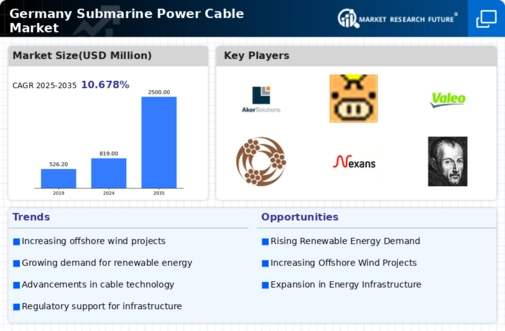Increasing Offshore Wind Capacity
The expansion of offshore wind farms in Germany is a primary driver for the submarine power-cable market. As the country aims to achieve its renewable energy targets, the government has set ambitious goals to increase offshore wind capacity to 20 GW by 2030. This surge in offshore wind projects necessitates the installation of advanced submarine power cables to transmit electricity efficiently from wind farms to the mainland. The submarine power-cable market is expected to benefit significantly from this trend, as the demand for high-capacity cables rises. Furthermore, the investment in offshore wind infrastructure is projected to reach approximately €30 billion by 2030, indicating a robust growth trajectory for the submarine power-cable market in Germany.
Technological Innovations in Cable Design
Technological advancements in cable design and materials are significantly influencing the submarine power-cable market. Innovations such as the development of high-voltage direct current (HVDC) technology enable more efficient transmission of electricity over long distances. This is particularly relevant for Germany, where the integration of renewable energy sources into the grid is essential. The submarine power-cable market is likely to see increased demand for HVDC cables, which can reduce transmission losses by up to 30%. As manufacturers invest in research and development, the market is expected to evolve, leading to enhanced performance and reliability of submarine cables.
Rising Energy Demand and Electrification Trends
The increasing energy demand in Germany, driven by electrification trends across various sectors, is a crucial driver for the submarine power-cable market. As industries and households transition towards electric solutions, the need for reliable and efficient energy transmission becomes paramount. The submarine power-cable market is poised to grow as utilities invest in expanding their infrastructure to meet this rising demand. Projections indicate that electricity consumption in Germany could increase by 15% by 2030, necessitating the deployment of additional submarine cables to ensure a stable energy supply. This trend underscores the importance of submarine power cables in supporting the country's energy transition.
Government Incentives for Infrastructure Development
The German government has implemented various incentives to promote infrastructure development, particularly in the renewable energy sector. These incentives include financial support and subsidies for projects involving submarine power cables. The government aims to enhance energy security and reduce carbon emissions, which aligns with its commitment to the Paris Agreement. As a result, the submarine power-cable market is likely to experience increased investments, with funding potentially exceeding €5 billion in the coming years. This financial backing encourages companies to innovate and expand their capabilities in cable manufacturing and installation, thereby driving growth in the submarine power-cable market.
Growing Interconnectivity with Neighboring Countries
Germany's strategic position in Europe fosters the need for enhanced interconnectivity with neighboring countries through submarine power cables. The establishment of interconnectors facilitates the exchange of renewable energy, promoting energy security and stability in the region. Projects such as the North Sea Wind Power Hub aim to connect multiple countries, including Germany, the Netherlands, and Denmark, through a network of submarine cables. This initiative is expected to bolster the submarine power-cable market, as it requires substantial investments in cable technology and infrastructure. The interconnectivity projects could potentially involve investments of over €10 billion, further stimulating the submarine power-cable market.






















Leave a Comment